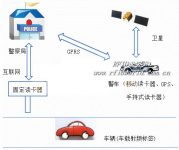
Active RFID vehicle automatic identification and anti-theft system application scheme
[ad_1]
1. Challenges and needs
With the rapid development of my country’s economy and transportation, the total number of vehicles in my country has exceeded 60 million at this stage, and it is growing at an annual rate of more than 10%. With the increase in vehicles, violations such as evading annual inspections, embezzling license plates, using fake license plates, and modifying stolen vehicles are increasing.
For violations of regulations and laws, in the past, the vehicle management department mainly relied on the establishment of cards and spot checks, temporary additional police and on-duty personnel for governance. The efficiency of this method of governance is extremely low, and on-site verification is very difficult. In terms of solving vehicle theft prevention, the GPS system is complicated and the charges are too high. In this case, RFID technology can be combined to reduce costs.
2. Application scheme
2.1 Vehicle automatic identification system based on active RFID
This system includes vehicle-mounted radio frequency tags, fixed card readers and mobile card readers.
2.1.1 Car radio frequency tags
Vehicle-mounted radio frequency tags have a unique ID in the world, and carry vehicle information, vehicle status, and vehicle owner information. The identification ID and its information are stored in the information exchange network of the public security department. Generally, they are in a static state and only start when the car is stolen or the owner requests traffic information inquiries. This identification number can help the police identify and track stolen vehicles. Car radio frequency tags need to be installed firmly, reliably, and concealed. They can be tampered with. Once they are disassembled, they will automatically alarm.
2.1.2 Fixed card reader
The reading distance range of the fixed card reader is 2 to 80 meters, and the fixed card reader is used to check, identify and record passing vehicles.
When a vehicle carrying an RFID tag passes near a fixed card reader, the card reader reads the ID in the tag, superimposes the passing time and transmits it to the server, and the server transmits the collected vehicle data information to the police station via the Internet. The management center of the transportation department also issues the control instructions of the management center to decide whether to release or intercept vehicles.
2.1.3 Mobile card reader
The mobile card reader can be equipped on a police car, which can be started at any time and parked in a designated place to conduct surprise inspections and identification of passing vehicles. The mobile card reader can be installed on the police car and keep in touch with the command center through the GPRS module.
2.1.4 Handheld card reader
Inspectors can use hand-held card readers to check passing vehicles at specific locations. The handheld card reader has downloaded the stolen vehicle information in advance, and once the same information is read, it will immediately call the police.
2.2 Anti-theft network based on active RFID and GPS
This system consists of a fixed card reader, a mobile card reader, a GPS positioning and navigation system, and a GPRS communication system. The schematic diagram is shown in Figure 1.

Figure 1 Schematic diagram of anti-theft system
When the vehicle is stolen, the police will call the police. The police will let each fixed card reader detect passing vehicles, read the RFID tags of the vehicles, and then compare with the target vehicle information. If it is the target vehicle, the vehicle ID, the location of the fixed card reader, and the time information are sent to the police via the Internet.
After the police received the signal, they sent text messages via GPRS to the police car equipped with mobile card readers and GPS. After the police car confirmed it, it found the best route through the GPS positioning and navigation system through route optimization, and continued to GPS itself. The location was sent to other police cars, and eventually the stolen vehicle was intercepted by a joint effort. The whole process is shown in Figure 2:

Figure 2 Schematic diagram of the process of recovering the anti-theft vehicle
Under the premise of ensuring anti-theft, the system adopts RFID technology to effectively reduce costs, save police force, and improve response speed. At the same time, the system is combined with the ETC system, the automatic equipment (logistics) identification (AEI) system, and the access control identification (GAI) system to form an important part of the intelligent transportation system.
3. Program features
(1) High recognition rate, frequency hopping technology is adopted, and the effect of anti-interference between the same frequency is good, and multiple vehicles can be recognized at the same time
(2) A globally unique identification number is used to indicate the identity of the vehicle, which is reliable, safe, and has no duplicate number.Equipped with mobile identification station (hand-held reader) for use under special circumstances
(3) The mobile identification station is very mobile and can communicate with the control center at any location covered by the GSM/CDMA network
(4) The cost of equipment is low, and the system is effective
(5) It can be identified within 80 meters, and can realize automatic identification
(6) Support high-speed mobile reading, and the moving speed of the mark card can reach more than 200 km/h
(7) High reliability, working temperature -40℃~85℃, waterproof and shockproof, suitable for outdoor operation in harsh environment
(8) High anti-interference: no special requirements for various interference sources on site, convenient and simple installation
(9) Globally open ISM microwave frequency band, no need to apply and pay
(10) Ultra-low power consumption: safer and healthier for the human body
For detailed plans, please contact: Shenzhen AIF Communication Co., Ltd.
Phone: 18923745421
[ad_2]



